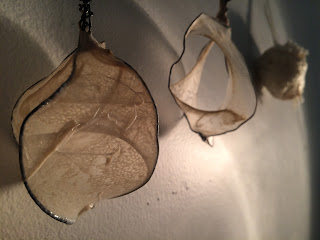 |
| An open section of the Klondike River today. |
Below, prime questions one might ask a resident artist at KIAC in December, wondering how in the hell one might cope with the cold and the dark and the isolation and the ghosts, answered by current artist-in-residence, me:
Q1: Doesn't the lack of light get to you?
A1: No. Full stop. I'm actually finding the dark comforting. Waking up in the dark is a peaceful and gentle way to enter a new day. The twilight is very slow and gradual, and also a mild entry into the daylight hours. It's beautiful and enchanting and exciting, to see any glimpse of colour (pink, gold) along the horizon in this all-white, snowy world. The short days mean that I'm urgently compelled (pressured, even) to get outside and hike around as much as possible before my face starts to freeze. I'm definitely getting more exercise here than in my normal Montreal life. I'm hiking about 2 hours a day, often uphill. The long, dark late afternoons and nights are internal, productive times. I have nothing too much to do but be with myself and to express as much of that as I can, while sipping red wine.
Q2: How can you handle the cold?
A2: It's not actually that cold. Montreal is colder, it seems. Today was about -13˚ and it felt similar to a Montreal -2˚. It's a tolerable cold, a dry cold, a cold that doesn't settle in the bones like wet cold does. Plus, a person realizes very clearly, once they've equipped themselves adequately for Yukon cold (good Sorel boots, North Face extreme cold gloves/mitts, decent puffy winter jacket, fur hat, plenty of thick socks and thermal leggings, snow pants, hand warmers) just how poorly they were equipped for any kind of cold anywhere else, previous to this. Now I'm properly equipped and I'll never suffer cold toes or fingers or ears again. Trudging around in knee-deep snow is fun again, like it was when I was a kid. I reminisced today about that time when I was young and I peed my snowpants from laughing so hard while playing outside with my friends. The cold here has freed me up to the cold anywhere. Then again, talk to me after -40˚ hits.
Q3: Wouldn't you rather be with your family or somewhere tropical at Christmas?
A3: Did that last year but yes, I'll miss them. However, I'll be Skyping them in Xmas eve, and my partner is flying in to stay a week with me. One Dawson resident told me recently that December is the most "Dawson-y" time of year: only the hardcore locals have stuck around. The community is small and friendly. People will actually look you in the eye and say hello on the street as if to acknowledge that you're an excellent human being, no matter that they've never seen you before in their lives. People will talk to you everywhere you go, pretty much, if you're the talkative type yourself. Not that there aren't introverts here, because there are, but there's also no fear of strangers. In December, most of Dawson is shut down and boarded up, making for a sleepy existence but for certain there's some serious mischief to be found if you're looking for it, or if you want to create it and invite others over to help you out.
Q4: How are you managing the ghosts?
A4: See image below.
-end Q&A-
 |
| My freshly baked loaf of Macaulay House Bread, for Little Charlotte, the hungry ghost. I had to bake it in a cake pan because there are no bread pans in the house. It turned out perfectly. |
I got busy in the studio last night and started playing with hog gut on some of the objects I found here, as well as made some new stuff -- stuff that isn't even really a part of my project idea but might eventually be. I realized how much I've missed just playing in a studio, outside of academia, outside of what needs to be explained to death in an artist statement. I realized just how perfect a thing this artist residency is on the heels of having just defended my master's thesis. I'm free up here, free to play and do nonsensical studio flow and allow some creative idea to unfold on its own without having to think about how I'm going to defend it later. Herein lies the gift of this time and place.
OH, and one final thing to this long post -- another presence spotted in my bedroom one dark morning... I think he's friendly.




No comments:
Post a Comment